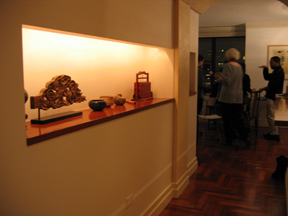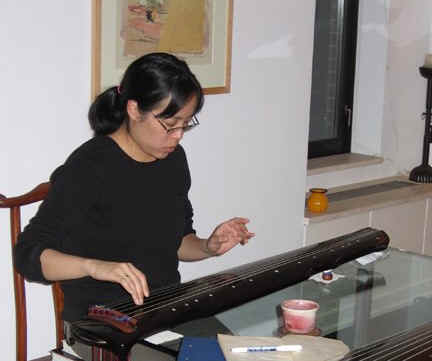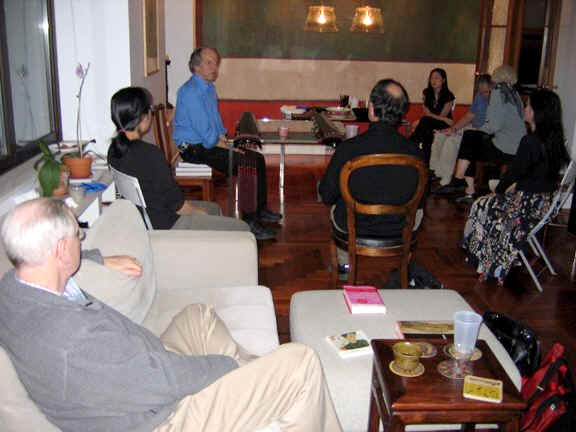

The elegant entrance.
On
12 November 2005 the following members of then New York Qin Society (NYQS)
attended a Society meeting: Elaine Sheng, Chang
Peiyou, Stephen Dydo, Matthew Flannery, Rebecca Flannery, Peter Reis, John
Thompson, Yip Ming-Mei. Guests were Sam Jamier and Stephen Bourne.
This
meeting was a somewhat informal gathering marking the return of members from
various activities overseas. Rebecca Flannery and Peter Reis were welcomed as
new members.
For business, Stephen announced that he has re-designed parts of the
Society's website, adding a section on Qin Culture. There was also some
discussion of the need for heightening awareness of the website, in which
regard Stephen suggested that we should make a better effort to provide
Chinese translations so that we can communicate our activities to players in
China.
Several
members then made presentations.
John
Thompson

John
played four of his reconstructions from Ming tablature, adding some
commentary. The first two were melodies from Shen Qi Mi Pu (1425)
actively played today.
Meihua
Sannong (Three
Repetitions of Plum Blossom)
The
Shen Qi Mi Pu version is quite different from the modern one. It still
has the Meihua melody played in harmonicis at three different
positions. But it has quite a different passage between the second and third
repetitions; a comment in the tablature says it is "the sound of
reading". This passage is repeated after the third Meihua
repetition, then a new passage is played with variations in both high and low
positions.
Wu
Ye Ti
(Evening Call of the Raven)
The
Shen Qi Mi Pu version was reconstructed in the 1950s, and many people
play this version or variations of it. John did his version without listening
to the others, so it differs in a number of points. The melody uses some old
fingering indications which are open to different interpretations.
The
other two were from his most recent reconstructions. They relate to famous
stories connected to Li Ling and Su Wu, historical figures from the 2nd c.
BCE, and the themes are often depicted in music, poetry and painting. He
finished his reconstructions so he could play them on November 6th at the
Williams College Museum of Art. He was invited there in conjunction with an
exhibition there called Masterworks of Chinese Painting, In Pursuit of Mist
and Clouds. One of the paintings, by Chen Hungshou, is called Su Wu Parts from
Li Ling
Li
Ling Si Han
(Li Ling Thinks of Han)
Li
Ling was a general sent by Han emperor Wudi to pacify the Xiongnu, a central
Asian nomadic people. Caught in a ambush and down to only a few people and no
weapons, Li Ling surrendered and allowed himself to be forced to work for the
Xiongnu; as a result the emperor executed Li Ling's family and he was unable
to return home. Section titles mention the battle, running out of arrows,
being captured, meeting a friend from home (Su Wu), then having to remain
behind when Su Wu is finally ransomed and returns home.
Han
Jie Cao
(Melody of Han Credentials)
Han
Wudi sent Su Wu with imperial credentials to negotiate peace with the Xiongnu,
but they detained him. He refused to serve them, instead working in the bleak
desert country as a shepherd. Su Wu the shepherd is a common theme in many
traditional Chinese media, including an episode where he is able secretly to
send a message home by tying it to the leg of a goose. After almost 20 years
in captivity he is ransomed, says a sad farewell to Li Ling (another
well-known theme in painting), and returns with honor to the Han palace in
Chang'an. The qin melody is quite evocative, with passages depicting
"chewing on a rug" to stay alive in the desert, hearing the sound of
geese, the sad farewell, and the happy return.
John showed how the musical mode shifted from tonal centers on do
and so to centering on la and mi.
Yip
Mingmei

Mingmei played and introduced three melodies.
Pingsha
Luo Yan
(Geese Settle on the Sandbank)
The
first handbook with Pingsha Luo Yan is quite late: 1634; nevertheless
it is the melody with probably the most number of printings, over 50, with as
many as five different versions in one handbook. Mingmei played one of the
versions she learned from her teacher, Cai Deyun. The many students of Madame
Cai in Hong Kong recently honored her on her 100th birthday.
Fenghuangtaishang
Yi Chui Xiao (On
Phoenix Terrace Recalling the Playing of a Flute)
Mingmei
played and sang this qin song based on her own reconstruction from the
Japanese handbook Hewen
Zhu(yin) Qinpu
(Wabun Chuyin Kinpu [?]). The book was reprinted in Qinqu Jicheng,
Vol. XII from an 1898 edition, but the song probably dates from the 17th or
18th century.
(The lyrics are translated in Xu Yuanzhang, Songs of the
Immortals, p.229, and probably elsewhere).
Guiqulai
Ci
(Come Away Home)
The
earliest qin setting of this famous poem by Tao Yuanming (365-425) is
in the Taigu Yiyin handbook of 1511. Mingmei sang the modern version,
which is musically very similar to the earliest version but is rarely sung.
The tablature can be found in the handbook of Yinyinshi Qinpu (2000),
the handbook of Madame Cai Deyun.
Chang
Peiyou

Peiyou
played two melodies.
Yi
Guren
(Thinking of an Old Friend)
The
earliest available version of this melody is found in the Jinyu Qin Kan
of 1937, which transcribes a performance by
Peng Qingshou (b. ca 1890 in Jiangxi province). This was first apparently
written in an old hand-copied tablature of the Li Qin Xuan (Regulated Qin
Pavilion). Peiyou's version is based on one originally learned from a
recording by the famous Suzhou qin player Wu Zhaoji, but
then modified by studying other recordings and tablature.
Liangxiao
Yin
(Peaceful Evening Prelude)
This
melody first survives from the Songxianguan Qinpu (1614) of Yan Cheng,
founder of the Yushan School of qin play. It can be found in over 30
handbooks and is still popular today. Peiyou's version is again based on a
recording by Wu Zhaoji.
Stephen
Dydo

Stephen
played:
Kongzi
Du Yi
(Confucius Reads the Book of Changes)
Stephen
learned this melody from Zeng Chengwei at a master class in London this past
July. This melody has the same theme as one called Du Yi, which occurs
in 5 handbooks from 1739 to 1894), but the only traditional handbook to
include the present melody is Tianwenge Qinpu (1876).
John
Thompson
Secretary
| HOME | QIN CULTURE | EVENTS | JOURNAL | RESOURCES | ABOUT | CONTACT |